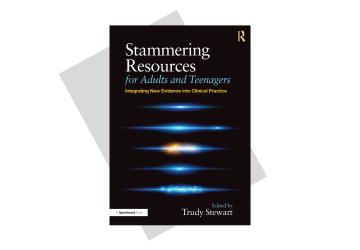
Book review: Stammering Resources
2nd June 2021
A speech & language therapist (SLT) and a person who stammers review a new book aimed at SLTS.
'Stammering Resources for Adults and Teenagers: Integrating New Evidence into Clinical Practice', edited by Trudy Stewart (published by Routledge).
The SLT's review
Speech & language therapist Teresa Howarth writes:
This is a particularly inspiring resource for speech & language therapists who are embarking on developing specialist skills in working with people who stammer. It is also a valuable update for more experienced therapists working in this complex area.
Each chapter presents information on the latest developments in the field of stammering therapy in an easily accessible format, while referencing up-to-date evidence and providing easy to use, adaptable resources.
Drawing together highly respected SLTs, Trudy has created a unique resource which offers detailed information and guidance. However this is not presented as a recipe book, but rather, there is an emphasis throughout on the importance of reflective practice and supervision, enabling the therapist to develop confidence in tailoring therapy to the individual.
Another theme that emerges in every chapter is the importance of working in collaboration with people who stammer. Here the emphasis is on developing an expertise in stammering therapy while not adopting the role of expert.
Whilst this book is a standalone resource for anyone wishing to learn more about the latest approaches to stammering therapy, I would also consider it a useful resource for any team of therapists to explore together, making use of the various exercises in group supervision sessions.
Teresa Howarth specialises in working with teenagers who stammer through Talking Out residential courses.
The person who stammer's review
STAMMA Chair Tim Fell writes:
When I heard about Stammering Resources for Adults and Teenagers, edited by Trudy Stewart, I contacted her and asked if she would like to donate a copy to the STAMMA library. Quick as a flash she agreed — on the understanding that I would write a review...
I need to make clear that although I'm a person who stammers, I'm not a speech & language therapist. And this book is clearly written for SLTs. It's a follow-up to the Dysfluency Resource Book (2010) and brings together some of the latest developments in stammering therapy for adults and teenagers. Each chapter is written by different people, all experts in their field, and SLTs will learn new ways of improving their therapy with people who stammer.
There's a preface written by two highly respected academics in the field which praises the technical qualities of the book.
But as a stammerer I found it fascinating. It was an eye-opener for me because I had no real idea what therapy was about. OK, I'd been to three speech therapists as a teenager/young man, but I went in desperation, and without a clue about what I was letting myself in for. However, the further I got into this book the more respect I felt for speech therapists in terms of the training they go through and the skills they accumulate. You come to realise how complex the subject is and, incidentally, what a big responsibility the therapist has.
The relationship between client and therapist is inevitably very personal and intimate. Of course, through no fault of those involved, some relationships will not work. In my conversations with people who stammer, some say that speech therapy has not worked for them. But it's crucial to find a therapist you can trust and with whom you can work together.
I feel that anyone who stammers would be well advised to read this book, or a book like it, before embarking on therapy. As a young man I had an irrational suspicion of therapists that, perhaps, undermined the chance of moving forward. This book could reposition the relationship between client and therapist to be more of a collaboration. I wish I had been better informed all those years ago.
There's one problem. Because this book is aimed at SLTs, it's too technical for many people who stammer. But I would like to see it rewritten as another version with people who stammer in mind as the audience so that they understand, and feel involved in, the process of therapy.
Is the outcome of therapy more likely to be successful if the client understands the process? It would be an interesting research project.
'Stammering Resources for Adults and Teenagers: Integrating New Evidence into Clinical Practice', edited by Trudy Stewart and published by Routledge, is available now on paperback, hardback and ebook from routledge.com.
(Picture courtesy of Routledge)






























